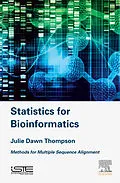Statistics for Bioinformatics: Methods for Multiple Sequence Alignment provides an in-depth introduction to the most widely used methods and software in the bioinformatics field. With the ever increasing flood of sequence information from genome sequencing projects, multiple sequence alignment has become one of the cornerstones of bioinformatics. Multiple sequence alignments are crucial for genome annotation, as well as the subsequent structural, functional, and evolutionary studies of genes and gene products. Consequently, there has been renewed interest in the development of novel multiple sequence alignment algorithms and more efficient programs. - Explains the dynamics that animate health systems - Explores tracks to build sustainable and equal architecture of health systems - Examines the advantages and disadvantages of the different approaches to care integration and the management of health information
Autorentext
Julie Dawn Thompson is a Senior Scientist at the French National Center for Scientific Research with expertise in theoretical bioinformatics, data mining, knowledge engineering, integrative bioinformatics and genomics, (LBGI) Stochastic Optimization and Nature inspired Computing (SONIC)
Inhalt
PART I: Fundamental concepts 1. Introduction 2. Multiple sequence applications
PART II: Traditional multiple sequence alignment methods 3. Heuristic approaches 4. Statistical approaches 5. Objective functions 6. Alignment benchmarks
PART III: Large-scale multiple sequence alignment methods 1. Efficient methods for multiple alignment of complete genome sequences 2. Efficient methods for multiple alignment of 1,000's of sequences 3. HPC implementations 4. Alignment quality analysis
